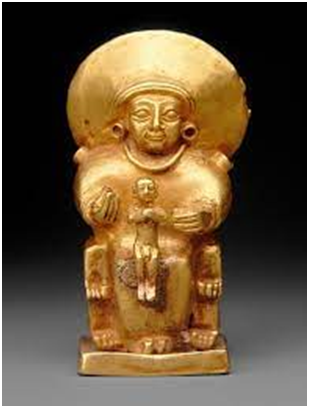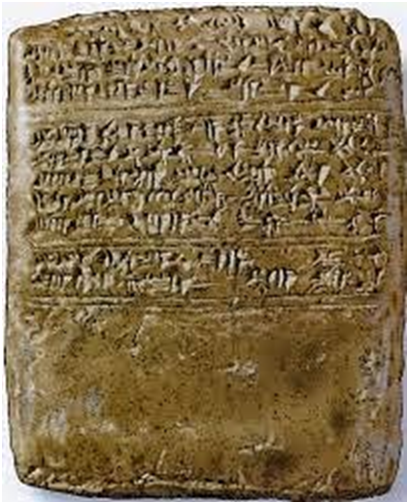The Vedic Sanatana roots of the Mitanni Empire
Vedic roots of the Mitanni Empire
1. Introduction
The Mittanni
empire stretched to the present-day northern Iraq, Syria and Turkey flourished
around 1500 BCE. The capital of Mitanni was Washukanni, located on the the
River Habur, a tributary of the Euphrates. The Assyrians knew this
kingdom as Hanigalbat (also Khanigalbat, Hani-Rabbat), and the Hittites referred to
these people as the Huri and their territory as the land of the Huri (or Hurri)
and land of the Hurrians.
To
the east, the Mitanni bordered with the Hurrian-speaking Kassites whose
territory corresponds to present-day Kurdistan. The lands of the Mitanni in
northern Syria bordered eastern Anatolia to its west and extended east as far
as Nuzi (present-day Kirkuk, Iraq) and the river Tigris in the east. In the
south, it extended from Aleppo across to Mari on the Euphrates to the east.
A very little information concerning the Mitannis is
obtained from their own sources. Most of
the information comes from Egyptian, Hittitie and Assyrian records. The
correspondence between the kings of the Mitanni with the Assyria and Egypts (the
Amara letters) as well as the world's oldest horse-training manual, and a
treaty between the Mitanni and Hittites, give information about this prosperous kingdom.
2. Mitanni connection to the Egyptians pharaoh
Mittanis had links to the Egyptians pharaohs. In this connection, the names of the Mitanni king Tushratta and the Egyptian pharaoh Akhenaten are worth mentioning. The Akhenaten of Egypt ruled between 1352-1336 BC. The Mitanni princess Tadukhipa, daughter of the Mitanni king Tushratta who was married to the pharaoh Amenhotep III. She became the wife of Akhenaten who was also known by the name of Amenhotep IV. The pharaohs were the worshiper of the Sun deity. The Egyptians considered the pharaohs as the form or the representative of the Sun deity Ra (In Sanskrit, the alphabet Ra is the beej mantra of the Surya or Ravi. The word Ravi meaning sun also comes from the Ra). There were many temples of Ra built in the Egypt by the pharaohs. The word p’haraoh might be the corruption of the Sanskrit word Saura meaning Sun. The Sanskrit alphabet ‘Sa’ is pronounced as ‘Ha’ in many parts of the world. So it is quite probable that the word Saura became p’haraoh.
3. The Sanskrit names of the Mitanni
kings.
The names of the Kings of Mittani
empire are given below.
|
Ruler |
Comment |
|
Kirta |
Reigned in
1500 BC |
|
Shuttarna I |
Son of Kirta |
|
Barattarna/Parshatatar/Parrattarna |
Son of Kirta |
|
Shaushtatar |
Contemporary
of Idrimi of Alalakh,
Sacks Ashur |
|
Artatama I |
Treaty
with Pharaoh Thutmose IV of Egypt,
Contemporary of Pharaoh Amenhotep
II of Egypt |
|
Shuttarna
II |
Daughter is married to the Pharaoh Amenhotep III of Egypt. |
|
Artashumara |
Son of
Shutarna II |
|
Tushratta |
Contemporary of Suppiluliuma I of the Hittites and Pharaohs Amenhotep III and Amenhotep IV (Akhenaten) of the Egypt, Amarna letters |
|
Shuttarna
III |
Contemporary
of Suppiluliuma I of the Hittites |
|
Shattiwaza or
Kurtiwaza |
Mittani
becomes subordinate to the Assyria under Adad-nirari
I |
|
Wasashatta |
Son of
Shattuara |
The pharaoh Akhenaten
was son-in-law of Tushratta. The name Tushratta recorded in the Hittite
cuneiform script might have been the corruption of the Sanskrit word Dasaratha
or Tvesaratha. The word Tvesaratha appears
in the Rigveda meaning the one who has splendid chariots. The names of other Mittani kings are also of Sanskrit
origin. Sutarna probably mean a great
refuge, Baratarna or Paratarna also ‘a great refuge), Parasuksatra (ruler
with axe); kṣatra
क्षत्र (a protector or ruler), Saustatar (Sauksatra, son of Suksatra,
the good ruler), Artadama (abiding in cosmic law), ṛta ऋत (fixed
or settled order, law, rule); ṛta
means an equitable law particularly when the subjects are governed by
the law of Dharma), Tushratta (Dasaratha), and Matiwazza (Mativaja,
one with a strong determination); mati मति means thought or determination . The alphabet 'arna' appearing in the names of the kings probably have
been the Sanskrit word araṇi
अरणि (sun) or araṇa अरण (a refuge or shelter).
|
A cuneiform inscription. |
4. The treaty signed by the Mitanni kings with their rivals
invokes the Vedic deities as divine witness.
The treaty signed by the Mitanni
kings with their rivals in 1380 BCE invokes the Vedic deities Indra,
Varuna, Mitra and the Nasatyas (Ashvins) as divine witnesses for the Mitannis. This
indicates that these people practiced the Sanatana philosophy and worshipped
the Vedic gods. These Deities are
mentioned in a Rigveda hymn in the same order as they are mentioned in this
treaty.
The Mitanni people practiced that Vedic
Sanatan Dharma. They worshipped the Divine Supreme in many forms. The linguistic
evidence and the reference of the Vedic deities
in Matanni documents indicate the Sanatana character of the people of the
Mitanni. Thus, we see that the names of the Mitanni rulers as well as their
deities are of Vedic origin (Mitra, Varuna, Indra, Nasatya).
The Mitanni rulers had alliance with the Egypt. The Mitanni king Shuttarna II in the early fourteenth century BCE married his daughter Gilu-Hepa to the Egyptian Pharaoh Amenhotep III. It is interesting to observe that as per the 'Amarna letter tablets' later Tushratta also married his daughter Taduhepa (also named as Tadukhipa) to the same Amenhotep III. After the death of Shuttarna, Tushratta, a son of Shuttarna became the ruler. At this time, the Hittite king Suppiluliuma I invaded some subordinate areas of the Mitanni empire.
The capital of Mitanni empire was Washukanni. After Tushratta, this empire became weak. The
Hittites and the Assyrians supported different pretenders to the throne.
Finally a Hittite army conquered the capital Washukkanni and installed
Shattiwaza, the son of Tushratta, as their subordinate king of Mitanni in the
late fourteenth century B.C.E.
5.
The discovery of the oldest
surviving horse-training manual.
Archeological excavations indicate that the Mitanni people
had a very good knowledge of the chariot making. They had developed the light war chariot with wheels that used spokes instead of the solid
wood wheels (used by the Sumerians), so that the chariots were
faster and easier to maneuver. The Hittite records of Hattusa (near present-day
Boğazkale,Turkey), found the oldest surviving horse-training manual in the
world written in 1345 BCE on four tablets.
It contains 1080 lines by a Mitanni horse-trainer named Kikkuli,
beginning with the words, "Thus speaks Kikkuli, master horse trainer of
the land of Mitanni" and elaborately gives the details for the proper horse
training.
6. ‘Amarna letter tablet’ from Tushratta.
The daughter of King Tushratta, the
princess Taduhepa (also named as Tadukhipa), was also married to Amenhotep III as
part of a treaty between these two nations. Sauska (also known as
Shaushka, Sausga, and Anzili) was the Hurrian-Hittite goddess
of fertility, war, and healing. She was worshipped throughout
the region known as Hanigalbat (present day Iraq, Syria, and Turkey) from the time
of the Hurrians (c.
3300 BCE), through the Kingdom of Mitanni (1500-1240
BCE), throughout the Hittite Empire (c.1344-1245 BCE), and beyond.
She is identified with
similar powerful female deities of other cultures, such as Innana/Ishtar of the
Akkadians and Assyrians, Isis of Egypt, Astarte of the Phoenicians, Usha
(Ushas) of the Rig Veda, Aphrodite of the
Greeks and Amaterasu of Japan.
Sauska was extremely
important to the Hurrians of Mitanni and the Hittites. She is also mentioned as highly honorable deity in
the ‘Amarna letters’ (correspondence between Egyptian pharaohs and
rulers of other nations found in the city of Amarna).

(Sauska)
Thus, Tushratta sent the
statue of the patron deity of Washukanni, the goddess of fertility Sauska, among other
valuable things with her daughter. Amenhotep III was ill at this time, and
Sauska, who also presided over healing, was sent to alleviate whatever ailed
him but also, as a goddess presiding over the marriage and love, to bless the
marriage and strengthen the union of the couple.
There are a large
number of words in the cuneiform
documents of the Mitanni kingdom having Sanskrit origin. The Mittanis were
Vedic people. They worshipped the Sun
and spoke the Hurrian language. The word
Hurrian probably can be the corruption of the world Surya (Ha for Sa). During the etymological studies of the origin
of different languages from the Sanskrit, it has been observed that the
Sanskrit alphabet ‘Sa’ is pronounced as ‘Ha’ in many parts of the world. There are other words also in the Hurrian language
with Sanskrit origin like babru and pabru (babhrú, ‘brown’), parita (palitá-
‘grey’) and pinkara (pingala, red).
Not only the Mitanni Kings but the Egyptian pharaohs also have names having
Sanskrit origin.
Recently, the
archaeologists have uncovered a 3,400-year-old Mittani Empire-era city once
located on the Tigris River. The settlement emerged from the waters of the
Mosul reservoir as water levels fell rapidly due to extreme drought in Iraq.
(Mittani Empire-era
city once located on the Tigris River discovered)
8.
The whole surrounding West Asia region was also practicing the Vedic Sanatana
Dharma
The Hittites, Kassites
and Mitanni civilizations in the West Asia region ruled Turkey and Syria with
Sanskrit names as Dasaratha and Pratardhana. The name Mitanni is connected with
Mithras of Vedas. Their capital Washukanni is connected with Vedic god Vasu
(Asta vasus). The word Syria came from Surya (the Sun deity mentioned in the
Vedas), Turkey came from Turaga/horse, Assyria came from Ashura, Iran came from
the word Aryan. So we see Vedic Sanskrit names spread everywhere. It is quite clear that the Hittites, Kassites
and Mitannis spoke a language related to Sanskrit. Dasaratha (Tushratta in
Mitanni inscriptions) married his two daughters to Egyptian Pharaoh. Mitannis singed
the treaty in the name of Vedic deities making them the divine witness to the
treaty. In Turkey, horse manuals in Sanskrit are found.
9. Conclusion
Dasaratha wrote letters to Egyptian king, married his daughter to an Egyptian king, sent a vigraha, statue of Devi Sauksa with her to the Egypt. The Goddess Sauksa is one of the many forms of the Supreme mother Goddess and is known by many names in different ancient cultures. In Sumer, she was called Inanna, in Egypt Isis or Ashe(t); in Babylon Ishtar, in Phoenician Astarte, in Canaan her name was Ashera, in Greece Aphrodite and in Rome Venus. The Devi Sauksa is definitely a form of Vedic deities Durga or Lakshmi.
(The Goddess Sauksa known
by the name of Ashe(t) in the Egypt;
Ishtar in Babylon and Astarte in Phoenicia)
Mitanni kings signed an
agreement in the name of the Vedic deities in the same order as these deities
are found in the Rig Vedic hymns.
Therefore, the Vedas are much older in origin than stated by the Max
Muller. The Mitanni people spoke a
language that was very closely related to the Sanskrit. The oldest horse manual
has been found in Turkey with instructions in Sanskrit language.
The above discussion
compels us to believe that the Vedic people who recited the Vedas did not come
to India from the central Europe but they were native to the Indian
Subcontinent. It was later that these
people spread to the different parts of the world. Here, in the instant case, they spread to the
West Asia carrying the Vedic Sanatana philosophy and practices and the Sanskrit language to that
region.








Comments
Post a Comment